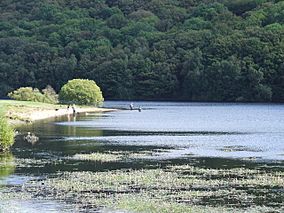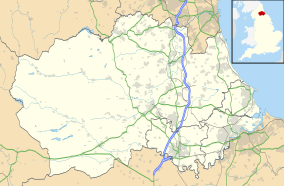Backstone Bank and Baal Hill Woods facts for kids
Quick facts for kids Backstone Bank and Baal Hill Woods |
|
|---|---|

Backstone Bank seen across Tunstall Reservoir
|
|
| Location | Wear Valley, North East, England |
| Area | 46.5 ha (115 acres) |
| Established | 1987 |
| Governing body | Natural England |
| Website | Map of site |
Backstone Bank and Baal Hill Woods is a really special place in County Durham, England. It's called a Site of Special Scientific Interest (SSSI) because it has amazing nature that needs to be protected. This beautiful woodland sits on the steep eastern side of the Waskerley Beck valley, near Tunstall Reservoir. It's one of the biggest areas of natural woodland in west Durham.
Contents
A Look Back in Time
This area was once part of a much larger forest called Wolsingham Park. It was owned by the prince bishops of Durham starting in the late 1200s. They protected the forest for its deer and for its timber.
The woodland was mostly made up of oak and birch trees. People managed the trees by a method called coppicing. This means cutting trees close to the ground so they grow new shoots. This provided wood for building and charcoal. Charcoal was important for the local lead industry, used in smelting kilns to melt metal.
Records show this area has been a woodland since at least the early 1500s. There's even a huge oak tree, called the "Bishop Oak," that's thought to be about 400 years old!
Amazing Plant Life
The types of trees and plants you find here change a lot depending on the soil and how wet it is.
Wet Areas and Special Trees
In wetter parts of the woods, you'll see lots of alder trees (Alnus glutinosa). The ground here is covered with plants like soft rush (Juncus effusus), meadowsweet (Filipendula ulmaria), and tufted hair-grass (Deschampsia cespitosa).
In one side valley, there's a small group of special trees called small-leaved lime (Tilia cordata). These trees are unusual here because they are close to their northern limit and grow at a very high altitude.
Rich Soil Woodlands
Where the soil has more nutrients, the woodland often has ash trees (Fraxinus excelsior) and wych elm (Ulmus glabra). Below these taller trees, you'll find hazel (Corylus avellana) and bird cherry (Prunus padus). The ground is rich with different ferns like lady-fern (Athyrium filix-femina), male fern (Dryopteris filix-mas), and hard shield-fern (Polystichum aculeatum).
Acid Soil Woodlands
On more acidic soils, sessile oak (Quercus petraea) and birch (Betula sp.) trees are the most common. The layer of smaller trees and shrubs like hazel, holly (Ilex aquifolium), rowan (Sorbus aucuparia), and hawthorn (Crataegus monogyna) is not as thick here. The ground doesn't have as many different plants.
Wonderful Wildlife
This special site is home to many different animals and birds. You might spot breeding birds like woodcock, wood warbler, common redstart, and pied flycatcher. Common buzzards are also often seen flying overhead.
You'll also find Roe deer living in the woods. There are enough deer that people need to take steps to protect the young tree saplings as they grow.
Protecting the Woods
The southern part of Backstone Bank and Baal Hill Woods is owned by the Durham Wildlife Trust. They manage this area as the Baal Hill Wood nature reserve, working to keep it healthy and safe for all its plants and animals.
What's in a Name?
The names "Baal Hill" and "Backstone Bank" have interesting stories behind them.
The Mystery of Baal Hill
People have different ideas about where the name "Baal Hill" comes from. One idea, which the Durham Wildlife Trust likes, connects it to the old lead-smelting industry. A "baal" or "bail" was a local word for a pit where lead ore was "boiled" to remove dirt. Old writings mention "les Bolehill" in Wolsingham and payments made to "bolers."
Another idea is that "baal" comes from an old spelling of "bailiff." A bailiff was like a local manager. So, the nearby Baal Hill House, mentioned in 1558 as "Baylehilhous," might have been where the Bishop of Durham's local bailiff lived. Some also think the name comes from an old northern word for a signal fire or beacon.
The Story of Backstone Bank
The name "Backstone Bank" was mentioned in 1647 as "Barkston Bank." It was described as a "hill where bakestones are found." Bakestones were flat stones that people used for baking food in an oven.


